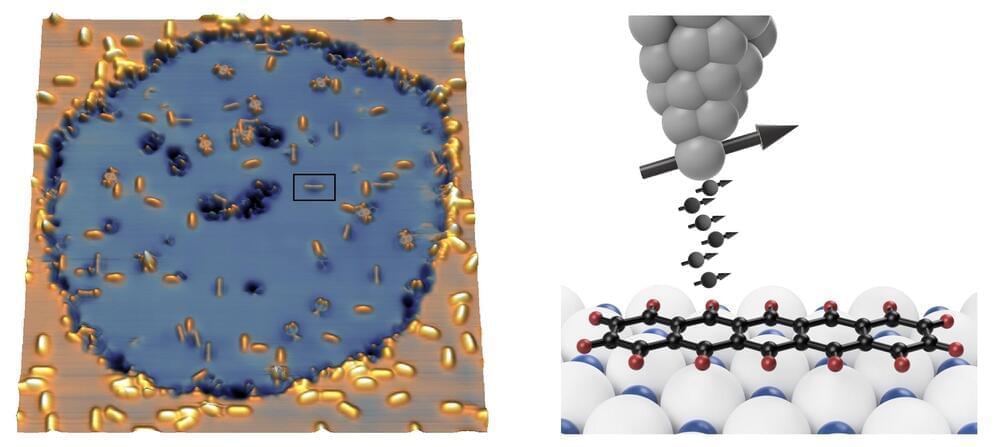A joint research team that included members from Tohoku University has unveiled a new topological insulator (TI), a unique state of matter that differs from conventional metals, insulators, and semiconductors.



Spin-orbit torque effects involve the transfer of angular momentum between a spin current and a magnetic layer mediated by the exchange interaction between conduction and localized electron.
Measuring these effects in magnetic materials continues to be a very active area of interest in spintronics…
Electrons have an intrinsic angular momentum, the so-called spin, which means that they can align themselves along a magnetic field, much like a compass needle. In addition to the electric charge of electrons, which determines their behavior in electronic circuits, their spin is increasingly used for storing and processing data.
Already, one can buy MRAM memory elements (magnetic random access memories), in which information is stored in very small but still classical magnets—that is, containing very many electron spins. The MRAMs are based on currents of electrons with spins aligned in parallel that can change the magnetization at a particular point in a material.
Pietro Gambardella and his collaborators at ETH Zurich now show that such spin-polarized currents can also be used to control the quantum states of single electron spins. Their results, which have just been published in the journal Science, could be used in different technologies in the future, for instance in the control of quantum states of quantum bits (qubits).

Learn more about quantum computing on Brilliant! First 30 days are free and 20% off the annual premium subscription when you use our link ➜ https://brilliant.org/sabine.
Quantum computing, so the fairy tale goes, is the next big thing in technology. News has popped up time and time again noting major advancements in the field, but the latest statement from company D-Wave had people scratching their heads. Are quantum computers really the next big thing? Who’s at the forefront of the field now? Let’s have a look.
Paper: https://arxiv.org/abs/2406.01743v1
🤓 Check out my new quiz app ➜ http://quizwithit.com/
💌 Support me on Donorbox ➜ https://donorbox.org/swtg.
📝 Transcripts and written news on Substack ➜ https://sciencewtg.substack.com/
👉 Transcript with links to references on Patreon ➜ / sabine.
📩 Free weekly science newsletter ➜ https://sabinehossenfelder.com/newsle…
👂 Audio only podcast ➜ https://open.spotify.com/show/0MkNfXl…
🔗 Join this channel to get access to perks ➜
/ @sabinehossenfelder.
🖼️ On instagram ➜ / sciencewtg.
#science #sciencenews #quantumcomputing #technology #technews #tech

A joint research team has unveiled a new topological insulator (TI), a unique state of matter that differs from conventional metals, insulators, and semiconductors. Unlike most known TIs, which are either three-or two-dimensional, this TI is one-dimensional. The breakthrough will lead to further developments of qubits and highly efficient solar cells.
Details of the research were published in the journal Nature (“Observation of edge states derived from topological helix chains”).
TIs boast an interior that behaves as an electrical insulator, meaning electrons cannot easily move; Whereas its surface acts as an electrical conductor, with the electrons able to move along the surface.

While investigating how string theory can be used to explain certain physical phenomena, scientists at the Indian Institute of Science (IISc) have stumbled upon on a new series representation for the irrational number π. It provides an easier way to extract π from calculations involved in deciphering processes like the quantum scattering of high-energy particles.

The so-called Casimir force or Casimir effect is a quantum mechanical phenomenon resulting from fluctuations in the electromagnetic field between two conducting or dielectric surfaces that are a short distance apart. Studies have shown that this force can be either be attractive or repulsive, depending on the dielectric and magnetic properties of the materials used in experiments.
Researchers at the Weizmann Institute of Science discovered a new type of vortex formed by photon interactions, which could advance quantum computing.
Vortex Phenomena
Vortices are a widespread natural phenomenon, observable in the swirling formations of galaxies, tornadoes, and hurricanes, as well as in simpler settings like a stirring cup of tea or the water spiraling down a bathtub drain. Typically, vortices arise when a rapidly moving substance such as air or water meets a slower-moving area, creating a circular motion around a fixed axis. Essentially, vortices serve to reconcile the differences in flow speeds between adjoining regions.

